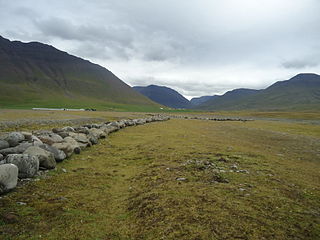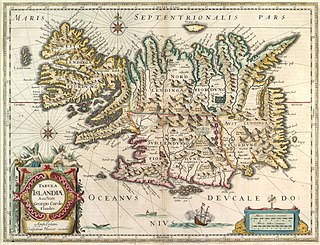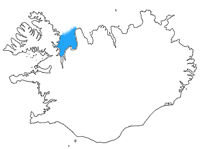Sagas are stories mostly about ancient Nordic and Germanic history, early Viking voyages, the battles that took place during the voyages, and migration to Iceland and of feuds between Icelandic families. They were written in the Old Norse language, mainly in Iceland.

Skálholt is a historical site in the south of Iceland, at the river Hvítá.

In Scandinavian mythology, Huld is only referenced by völva or seiðkona, that is a woman who practiced the seiðr. She is mentioned in the Ynglinga saga, Sturlunga saga and a late medieval Icelandic tale. In the latter source, she is Odin's mistress and the mother of the demi-goddesses Þorgerðr and Irpa. As her name suggests, Huld may be in origin the same being as the Huldra and the German Holda.

Sturlunga saga is a collection of Icelandic sagas by various authors from the 12th and 13th centuries; it was assembled in about 1300. It mostly deals with the story of the Sturlungs, a powerful family clan during the Age of the Sturlungs period of the Icelandic Commonwealth.

The Battle of Haugsnes was fought at Haugsnes, a low peninsula south of Flugumýri in Skagafjörður, Northern Iceland. The battle was fought on April 19, 1246 between the forces of Þórður kakali Sighvatsson and those of Gissur Þorvaldsson. Þórður was victorious. It was the bloodiest battle ever to be fought in Icelandic history, with about 110 casualties in total, amongst them Brandur Kolbeinsson, chieftain of the Ásbirningar family clan. Defeat in battle led to the end of power for the Ásbirningar.
Þórir jökull Steinfinnsson was an Icelandic 13th century warrior and possibly a skald.
The Battle of Örlygsstaðir was a historic battle fought by the Sturlungar against the Ásbirningar and the Haukdælir clans in northern Iceland. The battle was part of the civil war that was taking place in Iceland at the time between various powerful clans during the time known as the Age of the Sturlungs.
Þórður kakali Sighvatsson was a 13th-century Icelandic chieftain during the Age of the Sturlungs. He was the son of Sighvatur Sturluson, Snorri Sturluson's brother.
The Sturlungs were a powerful family clan in medieval mid-13th century Iceland, in the time of the Icelandic Commonwealth. Their story is partly told in Sturlunga saga, and members of the clan were significant participants in the civil war of the Age of the Sturlungs.
Sturla Þórðarson (1214–1284) was an Icelandic politician/chieftain and writer of sagas and contemporary history during the 13th century.
Gissur Thorvaldsson was a medieval Icelandic chieftain or goði of the Haukdælir family clan, and great-grandson of Jón Loftsson.

Arson in medieval Scandinaviawas a technique sometimes employed in blood feuds and political conflicts in order to assassinate someone. In committing arson, a group of attackers would set fire to the home of an opponent, sometimes by quickly and surreptitiously piling wood, brush and other combustible materials against the exterior of a dwelling and set it on fire. Typically the attackers would surround the house to prevent the escape of its inhabitants, although women, the elderly, and small children were sometimes allowed to leave.
SighvatrSturluson was a skaldic poet, goði and member of the Icelandic Sturlungar clan. His parents were Sturla Þórðarson of Hvammur and Guðný Böðvarsdóttir. His younger brother, the famous poet and historian Snorri Sturluson, grew up away from home, in Oddi, while Sighvatr and his elder brother Þórð(u)r were brought up in Hvammur. Nothing is known about his education. He married Kolbeinn Tumason’s sister Halldóra Tumadóttir, with whom he had a son, Sturla Sighvatsson.

Snorri Sturluson was an Icelandic historian, poet, and politician. He was elected twice as lawspeaker to the Icelandic parliament, the Althing. He was the author of the Prose Edda or Younger Edda, which consists of Gylfaginning, a narrative of Norse mythology, the Skáldskaparmál, a book of poetic language, and the Háttatal, a list of verse forms. He was also the author of the Heimskringla, a history of the Norwegian kings that begins with legendary material in Ynglinga saga and moves through to early medieval Scandinavian history. For stylistic and methodological reasons, Snorri is often taken to be the author of Egil's saga.

Nobility in Iceland may refer to the following:
Steinvör Sighvatsdóttir, was the politically most influential woman in Iceland in the Age of the Sturlungs. She was also a skáldkona (poetess), and the only woman listed in Skáldatal.
Arons saga Hjörleifssonar recounts the life of Aron Hjörleifsson, an important contemporary of Sturla Sighvatsson and Bishop Guðmundr Arason. The saga has been dated to around 1340, though it survives first in a fifteenth-century vellum fragment, with the earliest complete texts being the paper manuscripts AM 212 fol., AM 426 fol., and AM 399 4to.

Málmey is an uninhabited island off the northern coast of Iceland, one of the three islands in the Skagafjörður bay, along with Drangey and Lundey. It is located on the east side of the bay. Málmey is a long and narrow island, about 4 km long and about 1 km wide, and it is narrower at both the northern and southern ends. It is surrounded by cliffs on all sides, and it reaches an elevation of 156 m above sea level in its northern part.











